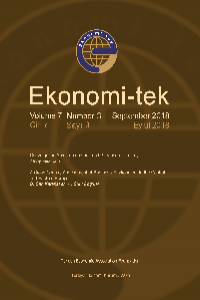On the Economic Content of the Gini Coefficient
This paper argues that the canonical assignment model, which is widely used in the study of wage determination, provides natural links to the standardized tools of inequality analysis, such as the Lorenz curve and the Gini coefficient. I show that an intuitive formula for the Gini coefficient of earnings can be derived using a standard assignment model. Such a model is useful in understanding the potential sources of earnings inequality, since it formulates the Gini coefficient as a function of the dispersion of worker skills, the distribution of firm productivities, and the strength of complementarities in production between capital and labor. The Gini coefficient increases with the dispersion of skills, the dispersion of productivities, and the labor share.
Anahtar Kelimeler:
Gini coefficient, earnings inequality, earnings equation, the assignment model
On the Economic Content of the Gini Coefficient
This paper argues that the canonical assignment model, which is widely used in the study of wage determination, provides natural links to the standardized tools of inequality analysis, such as the Lorenz curve and the Gini coefficient. I show that an intuitive formula for the Gini coefficient of earnings can be derived using a standard assignment model. Such a model is useful in understanding the potential sources of earnings inequality, since it formulates the Gini coefficient as a function of the dispersion of worker skills, the distribution of firm productivities, and the strength of complementarities in production between capital and labor. The Gini coefficient increases with the dispersion of skills, the dispersion of productivities, and the labor share.
___
- Aaberge, R., (2007), “Gini’s nuclear family,” Journal of Economic Inequality, 5, pp. 305–322.
- Adelman, I. G., (1958), “A stochastic analysis of the size distribution of firms,” American Statistical Association Journal, 53, pp. 893–900.
- Autor, D. H., L. F. Katz, and M. S. Kearney, (2008), “Trends in U.S. wage inequality: Revising the revisionists,” Review of Economics and Statistics, 90, pp. 300–323.
- Axtell, R. L., (2001), “Zipf distribution of U.S. firm sizes,” Science, 293, pp. 1818–1820.
- Azmat, G., A., Manning, and J. Van Reenen, (2011), “Privatization and the decline of labor’s share: International evidence from network industries,” Economica (forthcoming).
- Becker, G. S., (1973), “A theory of marriage: Part I,” Journal of Political Economy, 81, pp. 813–846.
- Card, D. and J. E. DiNardo, (2002), “Skill-biased technical change and rising wage inequality: Some problems and puzzles,” Journal of Labor Economics, 20, pp. 733–783.
- Card, D. and T. Lemieux, (2001), “Can falling supply explain the rising return to college for younger men? A cohort-based analysis,” Quarterly Journal of Economics, 116, pp. 705–746.
- Cowell, F. A., (2009), Measuring inequality. LSE Perspectives in Economic Analysis, Oxford University Press.
- Dunne, T., L. Foster, J. C. Haltiwanger, and K. Troske, (2004), “Wage and productivity dispersion in United States manufacturing: The role of computer investment,” Journal of Labor Economics, 22, pp. 397–429.
- Dustmann, C., J. Ludsteck, and U. Schoenberg, (2009), “Revisiting the German wage structure,” Quarterly Journal of Economics, 124, pp. 843–881.
- Faggio, G., K. G. Salvanes, and J. Van Reenen, (2010), “The evolution of inequality in productivity and wages: Panel data evidence,” Industrial and Corporate Change, 19, pp. 1919–1951.
- Gabaix, X. and A. Landier, (2008), “Why has CEO pay increased so much?” Quarterly Journal of Economics, 123, pp. 49–100.
- Glyn, A., (2009), “Functional distribution and inequality,” In: W. Salverda, B. Nolan, and T. M. Smeeding, eds., Oxford Handbook of Economic Inequality, Oxford, UK: Oxford University Press.
- Heckman, J. J. and D. V. Masterov, (2007), “The productivity argument for investing in young children,” Review of Agricultural Economics, 29, pp. 446–493.
- Helpman, E., O. Itskhoki, and S. Redding, (2010), “Inequality and unemployment in a global economy,” Econometrica, 78, pp. 1239–1283.
- Juhn, C., K. M. Murphy, and B. Pierce, (1993), “Wage inequality and the rise in returns to skill,” Journal of Political Economy, 101, pp. 410–442.
- Katz, L. F. and K. M. Murphy, (1992), “Changes in relative wages, 1963-87: Supply and demand factors,” Quarterly Journal of Economics, 90, pp. 35–78.
- Kopczuk, W., E. Saez, and J. Song, (2010), “Earnings inequality and mobility in the United States: Evidence from social-security data since 1937,” Quarterly Journal of Economics, 125, pp. 91–128.
- Lee, D. S., (1999), “Wage inequality during the 1980s: Rising dispersion or falling minimum wage?” Quarterly Journal of Economics, 114, pp. 977–1023.
- Lemieux, T., (2006), “Increasing residual wage inequality: Composition effects, noisy data, or rising demand for skill?” American Economic Review, 96, pp. 461–498.
- Luttmer, E. G. J., (2007), “Selection, growth, and the size distribution of firms,” Quarterly Journal of Economics, 122, pp. 1103–1144.
- Piketty, T. and E. Saez, (2003), “Income inequality in the United States, 1913- 1998,” Quarterly Journal of Economics, 118, pp. 1–39.
- Sattinger, M., (1979), “Differential rents and the distribution of earnings,” Oxford Economic Papers, 31, pp. 60–71.
- Sattinger, M., (1993), “Assignment models of the distribution of earnings,” Journal of Economic Literature, 31, pp. 831–880.
- Simon, H. A. and C. P. Bonini, (1958), “The size distribution of business firms,” American Economic Review, 48, pp. 607–617.
- Tervio, M., (2008), “The difference that CEOs make: An assignment model approach,” American Economic Review, 98, pp. 642–668.
- Tumen, S., (2011), “Measuring earnings inequality: An economic analysis of the Bonferroni index,” Review of Income and Wealth, 57, pp. 727– 744.
- ISSN: 2146-6173
- Yayın Aralığı: Yılda 3 Sayı
- Başlangıç: 2012
- Yayıncı: Türkiye Ekonomi Kurumu Vakfı
